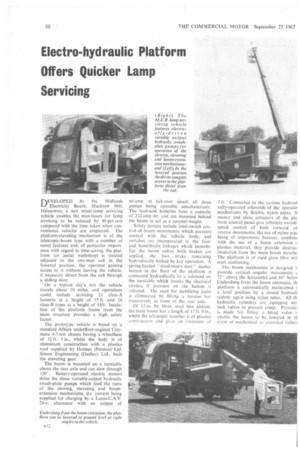Electro-hydraulic Platform Offers Quicker Lamp Servicing
Page 70

If you've noticed an error in this article please click here to report it so we can fix it.
DEVELOPED by the Midlands Electricity Board, Mucklow Hill. Halesowen, a new street-lamp servicing vehicle enables the man-hours for lamp servicing to be reduced by 40 per cent compared with the time taken when conventional vehicles are employed. The platform-elevating mechanism is of the telescopic-boom type with a number of novel features and of particular importance with regard to time-saving, the platform (or aerial workshop) is lockted adjacent to the one-man cab in the lowered position, the operator gaining access to it without leaving the vehicle. if necessary direct from the cab through a sliding door.
On a typical day's run the vehicle travels about 10 miles, and operations could include servicing 21 class-A lanterns at a height of 35 ft. and 28 class-B types at a height of 14ft. Insulation of the platform frame from the main structure provides a high safety factor.
The prototype vehicle is based on a standard Albion underfloor-engined Claymore 4-5-ton chassis having a wheelbase of 12 ft. 3 in., whilst the body is of aluminium construction with a plastics roof supplied by Holmes (Preston) Ltd. Simon Engineering (Dudley) Ltd., built the elevating gear.
The boom is mounted on a turntable above the rear axle and can slew through 1200. Battery-operated electric motors drive the three variable-output hydraulic swash-plate pumps which feed the rams of the stewing, elevating and boomextension mechanisms, d.c. current being supplied for charging by a Lucas-C.A.V. 24-v. alternator with an output of
60 amp. at tick-over Speed, all three pumps being operable simultaneously. The lead-acid batteries have a capacity of 232 amp.-hr. and are mounted behind the boom to act as a counter-weight.
Safety devices include limit-switch control of boom movements, which prevents contact with the vehicle body, and switches are incorporated in the footand hand-brake linkages which immobilize the boom unless both brakes arc applied, the foot brake remaining hydraulically locked by key operation. A spring-loaded "dead-man's foot" master button in the floor of the platform is connected hydraulically to a solenoid on the turntable which breaks the electrical circuits if pressure on the button is released. The need for stabilizing jacks is eliminated by fitting a torsion bar transversely in front of the rear axle.
Of 12-in. by 10-in, steel box section, the main boom has a length of 17 ft. 9 in.. whilst the telescopic member is of plastics construction and gives an extension of 7 ft, Connected to the various hydraul cally-operated solenoids of the operatic mechanisms by flexible nylon pipes, th master and slave actuators of the pla form control panel give infinitely-variabl speed control of both forward an reverse movements, the use of nylon pip( being of importance because, combine with the use of a boom extension r plastics material, they provide electric insulation from the main boom membe The platform is of rigid glass fibre wit steel reinforcing.
Theboom mechanism is designed t provide vertical angular movements ( 72° above the horizontal and 10° belov Underslung from the boom extension, th platform is automatically maintained i a level position by a closed hydrauli system. again using nylon tubes. All th hydraulic cylinders are equipped wit lock valves to prevent creep. Provisio is made for fitting a bleed valve t enable the boom to be lowered in th event of mechanical or electrical failure






















































































































